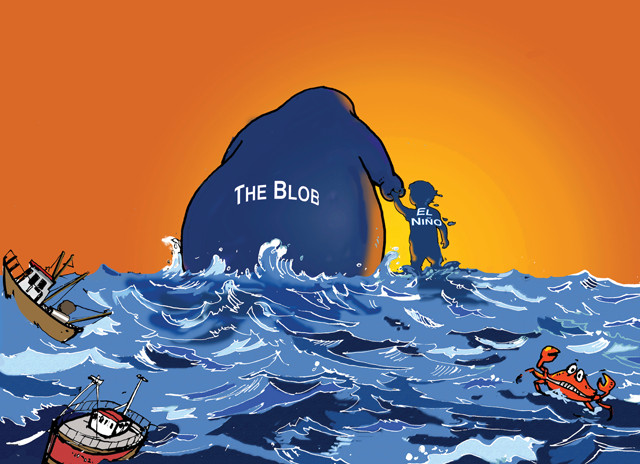
by Kate S. Zalzal Thursday, October 20, 2016

Two ocean conditions — El Niño and a mass of warm water known as "the Blob" — both affected the Pacific last year but have faded away. Credit: Leslie Bell (lesliebell.com).
The El Niño of 2015–2016, dubbed a “super El Niño,” was officially declared over in May, bringing to a close one of the strongest El Niño events on record. Scientists are now unraveling the details of this climate phenomenon, and discovering how it interacted with other unusual ocean conditions to impact surface and subsurface ocean conditions within the California Current System (CCS) — one of the world’s major coastal upwelling zones and a region of great biologic productivity.
In the CCS, winds blow south along the western U.S. coastline and, influenced by Earth’s rotation, surface waters move offshore. Deep, nutrient-rich waters then upwell to the surface, supporting rapid growth of the phytoplankton that serves as the foundation for a diverse ecosystem, critical to economically important fisheries, recreation and tourism.
Reduced upwelling, warmer water and a weakened supply of nutrients are characteristic effects of a strong El Niño within the CCS, says Michael Jacox, an oceanographer at the University of California, Santa Cruz, and NOAA’s Southwest Fisheries Science Center, and lead author of a new study published in Geophysical Research Letters. “We wanted to see how these signatures did, or didn’t, show up during this El Niño and how they compared to past El Niños of similar magnitude,” he says. “We’d like to understand how El Niño impacts the ecosystem and to move toward some level of predictability of those impacts.”
Jacox and his team used ocean modeling and satellite and underwater spray glider observations to look at anomalies in surface and subsurface temperature, in wind stress, and in the depth of a density horizon — a proxy for nutrient availability modulated by upwelling. The team then compared their results to El Niño-related conditions over the past 35 years. (Spray gliders are water vehicles that autonomously collect measurements in the upper kilometer of the ocean. Gliders run repeated surveys along tracks off the California coastline, recording ocean conditions in high resolution.)
Although the 2015–2016 El Niño was strongly expressed in the equatorial Pacific and in other parts of the world, Jacox and his team found that its impact on the CCS was relatively subdued. “This El Niño occurred on the backdrop of very strange pre-existing conditions. So while we saw lots of effects that we typically associate with El Niño — warm water, low primary productivity, warm water species spotted much farther north than normal — those things were already in place before El Niño arrived,” Jacox says.
The strange conditions are known as “the Blob,” a mass of warm water in the northeastern Pacific, first noticed in 2013, that has had widespread consequences, including drought, reduced water-column mixing and reduced upwelling. Peak sea-surface temperature anomalies during the 2015–2016 El Niño reached about 2.3 degrees Celsius — nearly identical to temperatures during the record El Niños of 1982–1983 and 1997–1998. But in the earlier events, this reflected a much larger increase over normal background temperatures. Other physical oceanographic responses to the 2015–2016 event were also weaker and slower than those in the previous record El Niños. Influenced by the unusual backdrop of warmth, “oceanic and atmospheric teleconnections — the pathways by which equatorial anomalies impact the CCS — were weaker than in past strong El Niños,” Jacox says.
With a better understanding of how climate disturbances impact productive upwelling regions like the CCS, the scientists hope to better predict ecosystem response. In one such correlation, Jacox and his team found a strong link between variability in wintertime density conditions and spring/summer chlorophyll measurements obtained from satellite observations.
Physical changes in the ocean during El Niños are generally greatest during the winter, but the ecosystem response is most pronounced during the spring upwelling season, says Martin Frischknecht, a graduate student at ETH Zürich in Switzerland who studies the CCS but was not involved with this work. “Changes in [density] in winter seem to have predictive skill,” he says, and the gliders, measuring density and other ocean characteristics on their repeated tracks, provide near real-time data on the physical state of the CCS. “Hopefully, this proves to be valuable for ocean management measures in the future,” Frischknecht says.
Physical ocean conditions in the Pacific began to recover last summer as El Niño and the Blob faded away, but in their wake was left a heavily disturbed ecosystem, with low productivity and conditions unfavorable to some native species. “As the physics gets back to normal, the food chain can recover,” Jacox says.
Although “the Blob was a big, unusual event,” he says, in the future, “multiyear warm events could become more frequent.”
Since this study was published, ocean conditions suggest that the Blob is re-forming.
© 2008-2021. All rights reserved. Any copying, redistribution or retransmission of any of the contents of this service without the expressed written permission of the American Geosciences Institute is expressly prohibited. Click here for all copyright requests.